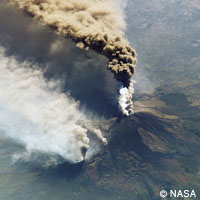Volcanoes perform for science
Scientists in Italy have devised a way to listen to the noises made by active volcanoes, and to use this information to predict when they might erupt. The seismic data readings from volcanoes are converted into music, in a process known as 'sonification'. It is not clear whether the volcanoes have the talent of say Tom Jones, but the result could be called music. The human ear is highly attentive to patterns, and if coherent patterns emerged in the data, audible representations could let researchers pick out the patterns easily. 'The human ear is a logarithmic device. It's much more sensitive than the human eye,' said Professor Roberto Barbera, physicist at the University of Catania in Italy. 'We can figure things out that we couldn't otherwise,' he told the New Scientist. Patterns that could be lost in a mountain of data might then be easily picked up. So far, the team's work has examined Mount Etna, the Sicilian volcano in an almost permanent state of eruption, and more recently the Tungurahua volcano in Ecuador. The technique involves measuring the complex seismic readings from the volcanoes, and then using the vast European GÉANT2 and nascent South American ALICE-RedCLARA grid systems to process information. 'Data sonification can be considered the acoustic counterpart of data graphic visualisation and is key to expanding our knowledge of volcanic seismic patterns to gain a deeper understanding of volcanic activity, especially when this activity precedes eruptive phenomena,' said the developer of the technology, Dr Domenico Vicinanza, who now works at CERN. The resulting noise can be mapped to various sounds. Two versions (see below), give piano interpretations. The Mount Etna piece is fast, hectic and with frequent pauses, while the Mount Tungurahua piece is slower but more flowing. Both pieces could masquerade as rather serious atonal avant-garde pieces. The information processing comes from the two Sixth Framework Programme-funded projects: Enabling Grids for E-sciencE (EGEE) and E-Infrastructure shared between Europe and Latin America (EELA). Work on the Tungurahua volcano uses a 622 Mbps transatlantic link to connect GÉANT2 to the ALICE-RedCLARA network. 'Through expanding this research to include Latin America's volcanoes we are hopeful we can build on and further develop the extensive data and information we have already obtained from the studies at Mount Etna,' said Professor Barbera.
Countries
Ecuador, Italy

